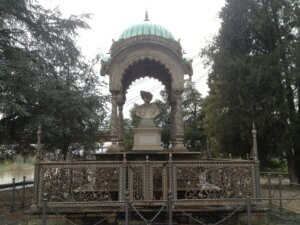
(Photo: Jessewaugh.com)
Cascine Park in Florence was the site of a recent visit to Italy by the Maharajah of Kolhapur, accompanied by several family members, who came to see the newly restored ‘Monumento all’Indiano’. Erected over 150 years ago to commemorate the 21-year old Rajaram Chuttraputti, Maharajah of Kolhapur, who died in Florence on 30 November 1870, the badly weathered monument has been sensitively conserved as part of a project supervised by Amina Anelli of the Comune di Firenze.
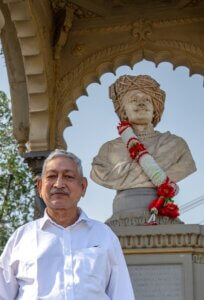
(Photo: Kirsten Hills, 2023)
Located at the extreme western edge of the park, where the Mugnone stream joins the river Arno, the monument coincidentally marks the site of the first legal cremation in Italy in modern times.
Rajaram, who had succeeded to the throne of Kolhapur (a district in South Maharashtra) at the age of 16, had been the first reigning Indian Prince to visit the British Isles. Arriving at Charing Cross station, London, on 14 June 1870, he recorded that he was met by ‘Mr Kaye, the Political Secretary’, and Sir Bartle Frere, the former Governor of Bombay.
In his diary (‘Diary of the late Rajah of Kolhapoor’), published after his death by Captain Edward West (the officer appointed by the HEIC to supervise his education), Rajaram recorded a breathtaking list of activities carried out over the next few months. In London, aside from enjoying his walks in the city’s large parks, he visited numerous famous sites, including Madame Tussaud’s Exhibition, the Tower of London (‘where people used to be beheaded formerly’), the Zoological Gardens, Kew Gardens, St Pauls Cathedral, Westminster Abbey, the Royal Academy, the British Museum, Lord’s Cricket Ground and Hampton Court.

(Vincent Brooks Day & Son, Lith. London)
Outside London he travelled by train to Liverpool, Manchester, Glasgow and Edinburgh, and also to Holyhead, where he caught the ferry to Dublin (‘I was very sick in crossing the channel, on account of its heaving’).
In addition to sightseeing, Rajaram was keen to familiarise himself with the affairs of state, both major and minor. He sat in on cases in various Magistrates courts (‘nicely arranged – four or five cases decided in five minutes. I was very much struck to see cases decided in this country in such a short time’). He listened to debates in both the House of Commons and the House of Lords, attended the Royal Horticultural Society rose show (‘Here were several kinds of rose, among which Marshal Neil was the best’), and presented prizes at Beckenham Cricket Ground. His evenings were taken up with theatre trips, visits to the Opera House, and scientific lectures – including one, illustrated with lantern slides, on the newly opened Suez Canal.
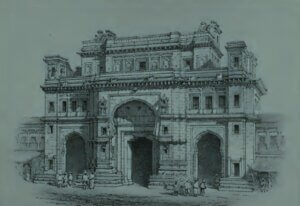
(From ‘Diary of the Late Rajah of Kolhapoor’)
Rajaram’s social life in the UK was a whirl of networking activities, presumably choreographed by the India Office. He was rapidly introduced (or possibly re-introduced) to a series of venerable gentlemen, such as Sir Robert Montgomery, Lord John Lawrence and Sir George Lawrence, who had retired to the UK after years of civil and/or military service in India. In Liverpool the Mayor introduced him to Sir Walter Elliott, ‘who knew my grandfather and the Kolhapoor territory very well’; in Edinburgh he met Francis Outram, ‘son of the famous Sir James Outram’, and managed a challenging cross-country rail trip to Brechin to meet the family of ‘Colonel A, the Political Agent at Kolapore‘, to whom he was ‘much attached’, and whose ‘relatives were very glad to see me, and they gave me a hearty reception’.
From London Rajaram was able to visit the 32-year old Maharajah Duleep Singh, then living at Elvedon, Suffolk. And, of course, he was presented to the 51-year old Queen Victoria (‘she appeared to be in good health, and to be a kind-hearted lady’), at Windsor Castle.

(From: Sister Julia Bolton Holloway)
Returning by train to Paddington after a Privy Council meeting, he commented ‘I was quite astonished to see the simple and unpretending ways of talking of the Ministers – especially of Mr Gladstone’, whom he later spotted ‘incognito’ in the audience at the Haymarket Theatre.
Being interested in art, Rajaram decided to visit European cities on his return journey to India. By the time his party reached Venice, he was suffering from rheumatism; his difficulty in walking meant that he had to be carried round the Piazza San Marco and the Doge’s Palace in a sedan chair.
In Florence Rajaram stayed at the Grand Hotel, overlooking the Arno. He became seriously ill, and died there on 30 November 1870.
Rajaram’s retinue of 11 servants (including his Parsee tutor) insisted that he must be cremated. Cremation was prohibited in Italy at the time, on religious and social grounds. However, attitudes were open to change: at the Medical International Congress held in Florence the previous year, Professors Coletti and Castiglioni had advocated cremation ‘in the name of public health and civilisation’, presenting it as a more sanitary alternative to burial. The British Consul, Augustus Paget, discussed the matter with the Mayor of Florence, and it was agreed that this particular cremation would be permitted, provided it was carried out after dark.
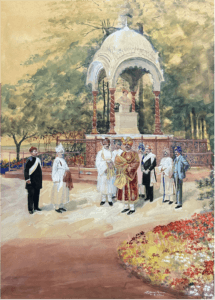
(www.the florentine.net)
Late that night a large number of spectators accompanied the horse-drawn carriage to the designated cremation site. The Municipal Police assisted in creating a funeral pyre; servants held paper lanterns, and the ceremony was performed with the agreement of all concerned.
The monument to the Maharajah was erected four years later. Charles Francis Fuller (1830-75), a sculptor living in Florence, was asked to create a bust. Based on photographs of Rajaram that had been taken in London, it shows him wearing a traditional Mahratta turban, with a peak on the right hand side.
Inscriptions at the base are in English, Italian, Hindi and Punjabi. The English inscription reads: ‘Erected to the memory of His Highness Rajaram Chuttraputti, Maharajah of Kolhapur, who died at Florence on the 30th November 1870, in his 21st year, while returning to India from England’.
The chhatri canopy was created by Major Charles Mant (1840-81), a Bengal engineer, and a selection of ‘Indian’ trees were planted round the monument.
A painting in the Kolhapur Palace Museum depicts Rajaram’s successor, His Highness Chhatrapati Shahu Maharaj of Kolhapur visiting the monument in 1911, with his brother Sir Pirajirao Ghatge, Chief of Kagal, and various courtiers.

(Photos: Amina Anelli)
Over the years the whole edifice began to deteriorate. From time to time the effects of weathering on the sandstone and marble were exacerbated by inappropriate reconstruction techniques. The long overdue conservation work was eventually initiated in 2019 as part of a project overseen by Senora Amina Anelli, Architect with the Comune di Firenze Technical Services Dept, and completed around a year later.

Conference Organiser
(Photo: 2023 City and Book X
Conference Proceedings)

Architect and Project Supervisor
(Photo: 2023 City and Book X
Conference Proceedings)
Recordings of a talk by Chowkidar Editor Rosie Llewellyn-Jones, covering the Maharajah’s life, and another by Amina Anelli, describing the conservation work on the monument, are included in the proceedings of the City and Book X Conference, organised by Sister Julia Bolton Holloway, on 15 April 2023.
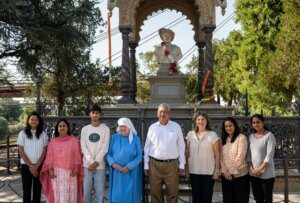
‘Monumento all’Indiano’, with Sister Holloway and Senora Anelli
(Photo: 2023 City and Book X Conference Proceedings)
Ed. Notes:
•Florence and India: International Conference
This post by Peter Boon, BACSA Hon Secretary, published on the BACSA website on 13 April 2023, lists several of the graves of around 40 people with Indian connections in the English Cemetery in Florence, identified by Sister Julia Bolton Holloway, Custodian of the Cemetery, and author of the book ‘Florence’s English Cemetery, 1827-1877, Thunders of White Silence’.
•Peasant and Prince – Modern India, on the eve of the New Reforms
This 1937 book by Glorney Bolton (Sister Julia’s father), mentions the Rajah of Kolhapur; Sister Julia was pleased to learn (from the current Maharajah) that there is a copy in the Kolhapur Palace library.
•23 March 2025: 140th anniversary of cremation in the UK
For those interested in the history of cremation in Europe – the Friends of Kensal Green cemetery, in NW London, are organising an event to mark the 140th anniversary of ‘the first cremation in modern times’ in the UK, on Sunday 23 March 2025. The event will include ‘a walk, a talk by author Brian Parsons, refreshments and a chance to look at the back rooms of the Crematorium’. Contact FOKG for details.
*************
(Can you help Sister Julia identify the ‘Indian’ tree? If so please let us know.
As always, suggestions for BACSA website news items are welcome at any time – please send them to ‘comms@bacsa.org.uk’.)
